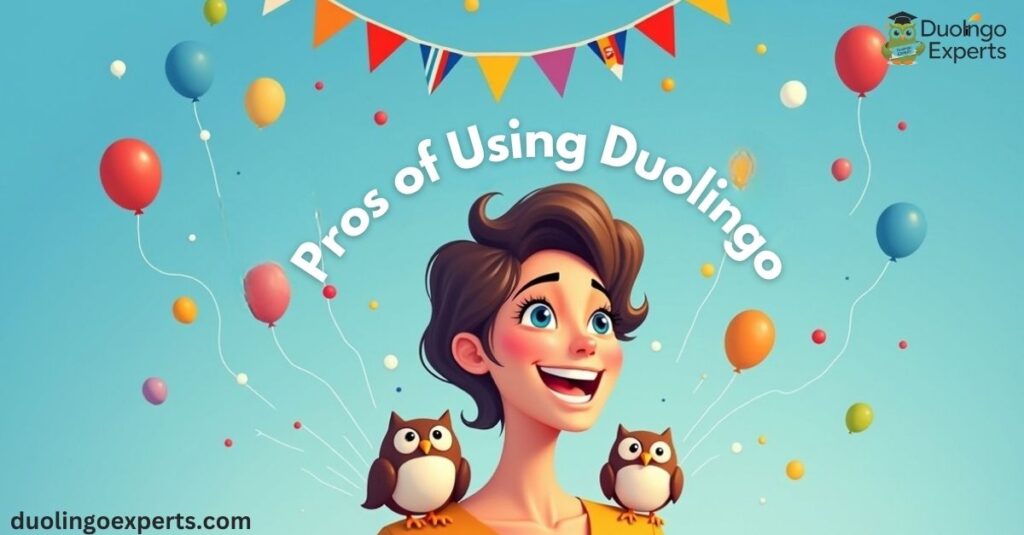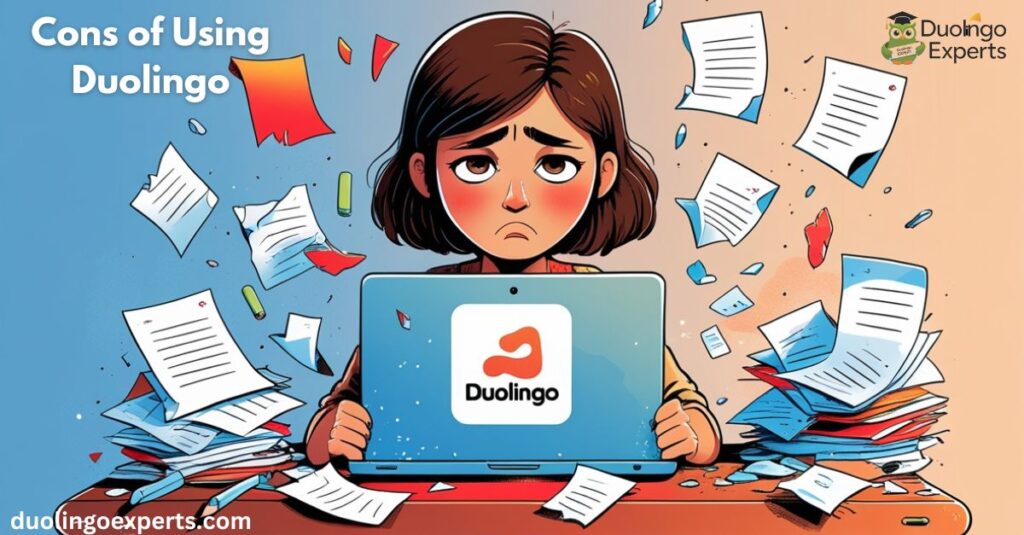Duolingo is one of the most popular language learning apps worldwide, used by millions of learners every day. With its gamified approach and free-to-use model, it promises an easy and engaging way to learn a new language. But with so many language learning apps on the market, is Duolingo really effective, or is it just a waste of time?
In this comprehensive review, we’ll explore both the pros and cons of Duolingo to help you determine if it’s the right tool for your language learning journey. Whether you’re a complete beginner, looking to brush up on your skills, or searching for a supplementary learning tool, this article will cover all you need to know.
Understanding Duolingo: A Quick Overview
Before diving into the pros and cons of Duolingo, let’s take a closer look at what the app offers. Launched in 2011, Duolingo has become one of the most popular language learning platforms, offering courses in dozens of languages.
Duolingo uses a unique, gamified approach to language learning that appeals to a wide variety of learners. Its main features include bite-sized lessons, gamification elements like leaderboards and streaks, and the ability to practice reading, writing, listening, and speaking skills.
The app’s main appeal lies in its free model, which gives learners access to the full set of features without having to spend a dime. There is also a paid version, Duolingo Plus, which removes ads and offers some additional benefits.
The Pros of Using Duolingo

Accessibility and Convenience
One of the biggest advantages of Duolingo is its accessibility. You can use it anytime, anywhere, making it perfect for busy learners. Whether you’re commuting, on a break, or relaxing at home, Duolingo allows you to practice your language skills in just a few minutes per day.
The app is available on both mobile and desktop, and it works seamlessly across platforms, so you can continue where you left off whether you’re using your phone or computer.
Free Language Learning
Another standout feature of Duolingo is its free model. Unlike many language learning platforms, Duolingo doesn’t charge for its basic language courses. This makes it incredibly accessible for anyone looking to start learning a new language without a financial commitment.
Although Duolingo does offer a paid version (Duolingo Plus), the free version provides a robust learning experience for beginners and intermediate learners. With no subscription required, learners can dive right into language learning without worrying about hidden costs.
Multiple Language Options
Duolingo supports a wide variety of languages, from widely spoken languages like Spanish and French to lesser-known ones like Haitian Creole and Irish.
This makes it an excellent choice for multilingual learners or polyglots who are interested in studying more than one language at a time. In fact, Duolingo supports over 30 languages, catering to the diverse needs of its global user base.
Gamification as Motivation
Duolingo’s gamified language learning approach is one of the most appealing features for many users. The app incorporates game-like elements such as:
- Leaderboards: Track your progress and compete with friends or other learners.
- Streaks: Build daily habits by maintaining your streak of consecutive learning days.
- XP Points: Earn points for completing lessons and tasks.
These elements help keep learners engaged and motivated, turning language learning into a fun and rewarding activity. The progress system ensures that you feel like you’re making tangible progress, even if you only study for a few minutes each day.
Beginner-Focused
Duolingo is particularly well-suited for beginners. Its lessons are structured in a way that guides users through basic vocabulary and grammar concepts before advancing to more complex language skills. The app offers a great starting point for those looking to build a solid foundation in their target language.
By providing easy-to-follow vocabulary drills, grammar drills, and listening exercises, Duolingo helps learners gradually build their skills in an accessible and structured way.
Community and Support
Duolingo has an extensive online community where users can interact, ask questions, and share tips. The app also offers discussion forums for each lesson, allowing learners to ask for clarification or advice from fellow users.
While Duolingo doesn’t provide personalized tutoring, its community support can be helpful for learners who need extra guidance or want to connect with others who are on the same language learning journey.
The Cons of Using Duolingo

Limited Depth for Advanced Learners
While Duolingo is a fantastic tool for beginners, it has significant limitations for learners who want to advance to higher levels of fluency.
Once you complete the initial levels of a language, you’ll find that the lessons become repetitive, and the app doesn’t offer much in terms of advanced vocabulary or in-depth grammar explanations. This lack of advanced learning features makes Duolingo less effective for learners who are striving to achieve true fluency.
Overemphasis on Gamification
Duolingo’s gamified design, while fun, can also be a double-edged sword. While gamification keeps learners engaged, it can sometimes lead to superficial learning. Many users focus on maintaining streaks or accumulating XP points rather than focusing on real-world language skills.
This can result in learners completing lessons quickly without fully understanding the material or applying it in real-life conversations. For those seeking deep, meaningful language acquisition, this can be a major drawback.
Inconsistent Pronunciation and Grammar
Duolingo’s pronunciation practice is often criticized for being inconsistent. While it uses computer-generated voices for pronunciation, these voices don’t always match the natural rhythms or intonations of native speakers.
Moreover, Duolingo’s grammar drills can be too focused on isolated sentence structures without providing in-depth grammar explanations or context for real-world language use. Without detailed grammar breakdowns or immersion in natural language usage, learners may struggle to understand complex structures in a conversation.
Focus on English-Speaking Learners
Most of Duolingo’s language courses are designed for English speakers, which means the app’s content is optimized for learners whose native language is English. This can be limiting for non-English speakers who wish to learn a language with Duolingo.
Additionally, Duolingo’s translation-based methods—which require users to translate sentences between languages are often criticized for being too focused on literal translation rather than teaching contextual understanding.
Limited Context for Real-World Conversations
Duolingo’s lessons are often highly structured and artificial, which can make them feel disconnected from real-world conversational skills. While Duolingo offers plenty of reading and listening practice, it doesn’t provide opportunities for native speaker interaction, which is crucial for improving your ability to engage in natural conversations.
Furthermore, the app often focuses on isolated vocabulary and phrases, which might not help learners navigate real-world situations where language is used in a more nuanced or contextual way. Without cultural context, learners may struggle to use language correctly in everyday situations.
Is Duolingo Effective for Learning a Language?
The key question many learners ask is, “Is Duolingo really effective?”
While Duolingo can be a great starting point for language learning, it has limitations in terms of fluency and in-depth proficiency. The app’s bite-sized lessons are designed for quick, easy learning, but they may not be enough to achieve fluency without additional resources or immersive experiences.

Studies have shown that Duolingo can help users learn basic vocabulary and sentence structures, but it falls short when it comes to developing conversational skills or mastering complex grammar. Duolingo is best used as a supplementary tool alongside more immersive methods, such as language exchange platforms, private tutoring, or real-world conversation practice.
Duolingo vs Other Language Learning Methods
How does Duolingo stack up against other language learning tools? Here’s a quick comparison:
| Feature | Duolingo | Babbel | Rosetta Stone | Private Tutoring |
|---|---|---|---|---|
| Free Access | Yes | No | No | No |
| Gamified Learning | Yes | No | No | No |
| Focus on Grammar | Basic | In-depth | In-depth | Personalized |
| Pronunciation Practice | Basic | Advanced | Advanced | Native Speaker |
| Cultural Context | Minimal | Moderate | High | High |
As shown in the table, Duolingo offers free access, but its gamified structure may not be suitable for learners seeking a more traditional, in-depth approach to language acquisition. In contrast, apps like Babbel and Rosetta Stone provide more structured learning, while private tutoring allows for personalized and immersive experiences.
Duolingo Plus: Is the Paid Version Worth It?
Duolingo offers a premium version called Duolingo Plus. For a subscription fee, users can enjoy:
- Ad-free experience
- Offline learning
- Progress tracking
- Healthier streaks (not interrupted by mistakes)
If you’re someone who uses Duolingo regularly and wants to avoid ads or need to learn while offline, Duolingo Plus might be worth considering. However, if you’re just starting out or want to try Duolingo before committing to a paid service, the free version is more than sufficient.
Frequently Asked Questions About is Duolingo a Waste of time
What are the disadvantages of Duolingo?
One of the key disadvantages of Duolingo is its limited depth for advanced learners, as it doesn’t provide enough grammar explanations or real-world conversation practice. Additionally, its focus on gamification can sometimes prioritize points and streaks over actual language proficiency.
Why are people leaving Duolingo?
People are leaving Duolingo due to its lack of advanced content and in-depth language immersion, which makes it difficult to achieve fluency. Additionally, some users find its gamification distracting and feel it doesn’t provide enough real-world conversation practice.
Is Duolingo actually useful?
Yes, Duolingo is useful for beginners to build basic vocabulary and understand basic grammar. However, it may not be sufficient for achieving fluency or mastering more complex language skills without additional resources.
Is Duolingo losing popularity?
Some users feel Duolingo is losing popularity due to its lack of advanced learning features and the rise of more immersive, comprehensive platforms. Additionally, its heavy reliance on gamification may not appeal to those seeking more serious language study.
Can you actually become fluent from Duolingo?
While Duolingo can help you build a strong foundation in a new language, it’s unlikely to make you fully fluent on its own. To achieve fluency, you’ll need to combine Duolingo with real-world practice, such as conversations with native speakers and immersion experiences.
Why is Duolingo so controversial?
Duolingo is controversial due to its reliance on gamification, which some argue prioritizes rewards over true language comprehension. Additionally, its lack of advanced content and focus on basic skills leaves some learners frustrated with its ability to foster fluency.
What does XP stand for in Duolingo?
In Duolingo, XP stands for experience points, which are earned by completing lessons and tasks. These points track your progress and motivate you to keep learning and maintain your daily streak.
Why is Duolingo falling?
Duolingo is facing decline due to its limited depth for advanced learners and reliance on gamification rather than real language proficiency. Users seeking more immersive and comprehensive language learning options are turning to other platforms.
What is the disadvantage of Duolingo?
A major disadvantage of Duolingo is its focus on basic vocabulary and gamification, which can hinder real language immersion and deeper skill development. Additionally, it lacks sufficient advanced grammar explanations and conversational practice.
What percent of Duolingo users finish?
Only about 5% of Duolingo users complete a full language course. Many learners drop off after reaching basic levels, as the app lacks the depth needed for advanced fluency.
Conclusion: Is Duolingo a Waste of Time?
So, is Duolingo a waste of time? It depends on your language learning goals. If you’re a beginner looking to get started, Duolingo is a fantastic tool. Its free access, gamified system, and multiple languages make it an excellent choice for casual learners or those who need a quick refresher.
However, if you’re seeking fluency or more advanced language skills, Duolingo might not be enough on its own. For advanced learners, supplementary methods like private tutoring, language immersion, or language exchange platforms may be necessary to reach your goals.
In the end, Duolingo isn’t a waste of time, but it’s important to manage expectations and combine it with other tools and techniques to achieve comprehensive language proficiency.

DuolingoExperts, managed by MarkJohan, offers expert insights and tips for mastering languages. A tech-driven platform to enhance your learning experience.

